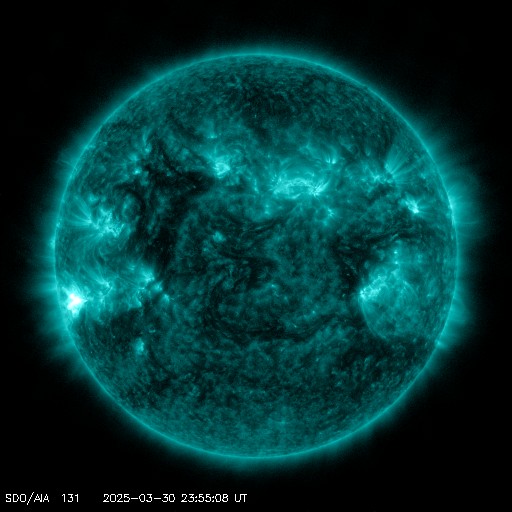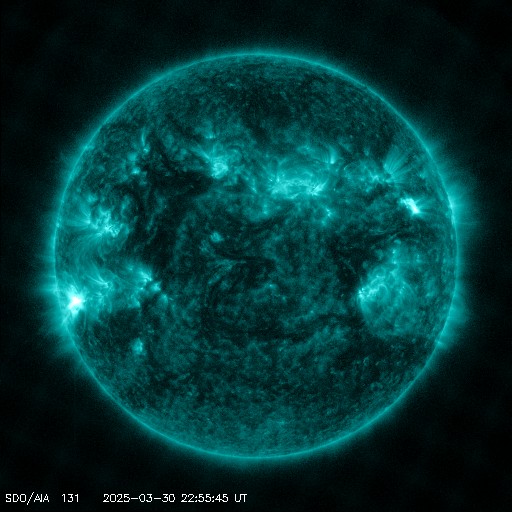Viewing archive of Sunday, 13 March 2011
Solar activity report
Any mentioned solar flare in this report has a scaling factor applied by the Space Weather Prediction Center (SWPC). Because of the SWPC scaling factor, solar flares are reported as 42% smaller than for the science quality data. The scaling factor has been removed from our archived solar flare data to reflect the true physical units.
Report of Solar-Geophysical Activity 2011 Mar 13 2200 UTCPrepared by the NOAA © SWPC and processed by SpaceWeatherLive.com
Joint USAF/NOAA Report of Solar and Geophysical Activity
SDF Number 072 Issued at 2200Z on 13 Mar 2011IA. Analysis of Solar Active Regions and Activity from 12-2100Z to 13-2100Z
Solar activity was low. Regions 1166 (N10W65) and 1169
(N20W34) have both produced C-class events. The daily consensus has
Region 1166 as decreased in both white light areal coverage and
sunspot count with a Ekc type spot group and a beta-gamma magnetic
classification. Region 1169 has maintained its area and spot count
and is a simple beta magnetic classification with a Cro type spot
group.
IB. Solar Activity Forecast
Solar activity is expected to be low
with a chance for an M-class event.
IIA. Geophysical Activity Summary 12-2100Z to 13-2100Z
The geomagnetic field was quiet to unsettled. The ACE spacecraft
observed solar wind speeds during the past 24 hours averaging around
550 km/s with the interplanetary magnetic field Bz fluctuating
between -4/+5 nT. Observations suggest that the earth is still
under the influence of the coronal hole high speed stream. The
greater than 2 MeV electron flux at geosynchronous orbit reached
high levels during the period.
IIB. Geophysical Activity Forecast
The geomagnetic field is
expected to be quiet to unsettled with a chance for isolated active
levels for day one (14 March). Days two and three (15-16 March) are
expected to be predominately quiet as the effects from the coronal
hole high speed stream subside.
III. Event Probabilities 14 Mar to 16 Mar
| Class M | 40% | 20% | 20% |
| Class X | 05% | 01% | 01% |
| Proton | 01% | 01% | 01% |
| PCAF | green | ||
IV. Penticton 10.7 cm Flux
Observed 13 Mar 113 Predicted 14 Mar-16 Mar 110/110/110 90 Day Mean 13 Mar 093
V. Geomagnetic A Indices
Observed Afr/Ap 12 Mar 010/013 Estimated Afr/Ap 13 Mar 005/005 Predicted Afr/Ap 14 Mar-16 Mar 008/008-005/005-005/005
VI. Geomagnetic Activity Probabilities 14 Mar to 16 Mar
| A. Middle Latitudes | |||
|---|---|---|---|
| Active | 25% | 05% | 05% |
| Minor storm | 05% | 01% | 01% |
| Major-severe storm | 01% | 01% | 01% |
| B. High Latitudes | |||
|---|---|---|---|
| Active | 30% | 05% | 05% |
| Minor storm | 10% | 01% | 01% |
| Major-severe storm | 01% | 01% | 01% |
All times in UTC
Current data suggests there is a slight possibility for aurora to appear at the following high latitude regions in the near future
Gillam, MB, Whitehorse, YT, Yellowknife, NTFairbanks, AK, Utqiagvik, AK
Latest news
Latest forum messages
Solar Demon 3Unspecified geomagnetic activity 2146AR4046 134Aurora photography hints for those of us with smartphones 54AR4048 34
More topicsSupport SpaceWeatherLive.com!
A lot of people come to SpaceWeatherLive to follow the Sun's activity or if there is aurora to be seen, but with more traffic comes higher server costs. Consider a donation if you enjoy SpaceWeatherLive so we can keep the website online!

Latest alerts
00:09 UTC - Solar flare
Moderate M1.03 flare
Sunday, 30 March 2025
23:51 UTC - Radio Blackout
Minor R1 radio blackout in progress (≥M1 - current: M1.03)
23:39 UTC - Solar flare
Moderate M1.52 flare
23:21 UTC - Radio Blackout
Minor R1 radio blackout in progress (≥M1 - current: M1.49)
23:09 UTC - Solar flare
Moderate M1.48 flare
Space weather facts
| Last X-flare | 2025/03/28 | X1.1 |
| Last M-flare | 2025/03/30 | M1.0 |
| Last geomagnetic storm | 2025/03/27 | Kp5 (G1) |
| Spotless days | |
|---|---|
| Last spotless day | 2022/06/08 |
| Monthly mean Sunspot Number | |
|---|---|
| February 2025 | 154.6 +17.6 |
| March 2025 | 127 -27.6 |
| Last 30 days | 127 -25.7 |





